Virtual Pressure Sensor for Electronic Expansion Valve Control in a Vapor Compression Refrigeration System
Abstract
1. Introduction
2. Mathematic Model of Virtual Pressure Sensor
- The refrigerant suction side pressure loss through the evaporator is a function of mass flow rate.
- The refrigerant discharge side pressure loss through the condenser and economized heat exchanger is a function of mass flow rate.
- The energy loss when the refrigerant passes through the expansion valve is negligible.
- It should be noted that the approaches discussed in this paper assume the refrigerant does not have a varying saturation temperature for a specific pressure (generally referred to as “glide”).
- The condenser fan is at a constant speed.
- The physical sensors for inputs of this model are assumed to be fault free.
3. Model Calibration and Validation
- Test Case 1: The refrigerated space temperature was cooled from 37.8 °C to −17.8 °C under 37.8 °C ambient temperature.
- Test Case 2: The refrigerated space temperature was cooled from 15.6 °C to −17.8 °C under 15.6 °C ambient temperature.
- Test Case 3: The refrigerated space temperature was cooled from 37.8 °C to 0 °C under 37.8 °C ambient temperature.
- The proposed virtual pressure sensor can estimate the pressure/superheat temperature with reasonable accuracy to support EXV control.
- The proposed method has better accuracy in the pressure/superheat temperature estimation in the full load/near full load conditions than partial load conditions (Figure 6).
- The pressure/superheat temperature estimate is not applied for the EXV saturation condition when the EXV is fully open at 100% and EXV control is not needed.
4. Electronic Expansion Valve (EXV) Control Using Virtual Pressure Sensor
- MIL simulation scenario 1: The refrigerated space temperature was cooled from 37.8 °C to 13.9 °C under 37.8 °C ambient temperature.
- MIL simulation scenario 2: The refrigerated space temperature was cooled from 37.8 °C to 1.7 °C under 37.8 °C ambient temperature.
- MIL simulation scenario 3: The refrigerated space temperature was cooled from 37.8 °C to −17.8 °C under 37.8 °C ambient temperature.
- Suction pressure: to evaluate the virtual pressure sensor pressure prediction accuracy.
- EXV position: to evaluate the impact of virtual pressure sensor performance on the EXV controller output.
- Evaporator supply/return air temperature: to evaluate the impact of virtual pressure sensor performance on the controlled temperature.
- The EXV control using the proposed virtual pressure sensor could control the supply/return temperature very well at all three test examples: the virtual pressure sensor-based EXV control maintains almost the same supply/return air temperature as the measured pressure EXV control.
- The suction pressure calculated by the virtual pressure sensor matches well with the actual measured pressure in most of operating conditions except for a few narrow operation zones, such as the transition zone from full load operation to partial load operation in MIL simulation scenario 1 and a small operation zone during full load operation in MIL simulation scenario 2. These discrepancies result in different EXV opening position. These errors are generally caused by a model error of the virtual suction pressure senor. Fortunately, the impact of these pressure calculation errors on a controlled objective, supply/return air temperature, are relatively small and can be ignored.
- When the system is running with a compressor pulse width modulation control zone, the calculated suction pressure based on the virtual pressure sensor model agrees with the average actual pressure but cannot match the dynamic characteristics of the actual pressure. The primary reason is that the proposed virtual pressure sensor is a steady-state model and cannot handle the dynamic change of pressure. This drawback of the virtual pressure sensor has little influence on the EXV control performance since the EXV control takes the average pressure signal as input to calculate the control output signal.
5. Conclusions
Author Contributions
Funding
Acknowledgments
Conflicts of Interest
Nomenclature
| Symbols | |
| A | Area, m2 |
| C | Constant/parameter |
| dP | Pressure drop, pa |
| CF | Correction factor |
| Exv% | Electronic expansion valve opening, % |
| m | Mass flow rate, kg/s |
| N | Compressor speed, rpm |
| P | Pressure, pa |
| T | Temperature, °C |
| V | Volumetric flow rate, m3/s |
| ρ | Density, kg/m3 |
| γ | Isentropic exponent |
| Subscripts and abbreviations | |
| air | Air side |
| comp | Compressor |
| dis, d | Compressor discharge port |
| disp | Compressor displacement |
| exv, EXV | Electronic expansion valve |
| in | Electronic expansion valve inlet |
| init | Initial value |
| norm | Normalized value |
| out | Electronic expansion valve outlet |
| suc, s | Compressor suction port |
| 0,1,2,3 | State number, constant number |
References
- Andiroglu, E.; Wang, G.; Song, L.; Kiamehr, K. Development of a Virtual Pump Water Flow Meter Using Power Derived from Comprehensive Energy Loss Analysis. Sci. Technol. Built Environ. 2016, 22, 214–226. [Google Scholar] [CrossRef]
- McDonald, E.; Zmeureanu, R. Virtual Flow Meter for Chilled and Condenser Water for Chiller: Estimates Versus Measurements. Sci. Technol. Built Environ. 2016, 22, 178–188. [Google Scholar] [CrossRef]
- Bach, C.K.; Groll, E.A.; Braun, J.E.; Horton, W.T. Development of a Virtual EXV Flow Sensor for Applications with Two-Phase Flow Inlet Conditions. Int. J. Refrig. 2014, 45, 243–250. [Google Scholar] [CrossRef]
- Li, H.; Braun, J. Virtual Refrigeration Pressure Sensors for Use in Monitoring and Fault Diagnosis of Vapor-Compressor Equipment. HAVC&R Res. 2009, 15, 597–616. [Google Scholar]
- Kim, W.; Braun, J. Performance Evaluation of a Virtual Refrigerant Charge Sensor. Int. J. Refrig. 2013, 36, 1130–1141. [Google Scholar] [CrossRef]
- Kim, W.; Braun, J. Extension of a Virtual Refrigeration Charge Sensor. Int. J. Refrig. 2015, 55, 224–235. [Google Scholar] [CrossRef]
- Li, H.; Braun, J. Development, Evaluation and Demonstration of a Virtual Refrigerant Charge Sensor. HAVC&R Res. 2009, 15, 117–136. [Google Scholar]
- Zhao, X.; Yang, M.; Li, H. A Virtual Condenser Fouling Sensor for Chiller. Energy Build. 2012, 52, 68–76. [Google Scholar] [CrossRef]
- Hjortland, A.; Braun, J. Virtual Sensors for Rooftop Unit Air-Side Diagnostics. Sci. Technol. Built Environ. 2016, 22, 189–200. [Google Scholar] [CrossRef]
- Li, H.; Braun, J. Decoupling Features and Virtual Sensors for Diagnosis of Faults in Vapor Compression Air Conditioners. Int. J. Refrig. 2007, 30, 546–564. [Google Scholar] [CrossRef]
- Yoon, S.; Yu, Y. Strategies for Virtual In-Situ Sensor Calibration in Building Energy Systems. Energy Build. 2018, 172, 22–34. [Google Scholar] [CrossRef]
- Wang, P.; Yoon, S.; Wang, J.; Yu, Y. Automated Reviving Calibration Strategy for Virtual In-Situ Sensor Calibration in Building Energy Systems: Sensitivity Coefficient Optimization. Energy Build. 2019, 198, 291–304. [Google Scholar] [CrossRef]
- Kuehn, T.H.; Ramsey, J.W.; Threlkeld, J.L. Thermal Environmental Engineering, 3rd ed.; Prentice Hall: Upper Saddle River, NJ, USA, 1998. [Google Scholar]
- Xue, Z.; Shi, L.; Ou, H. Refrigeration Flow Characteristics of Electronic Expansion Valve Based on Thermodynamic Analysis and Experiment. Appl. Therm. Eng. 2008, 28, 238–243. [Google Scholar]
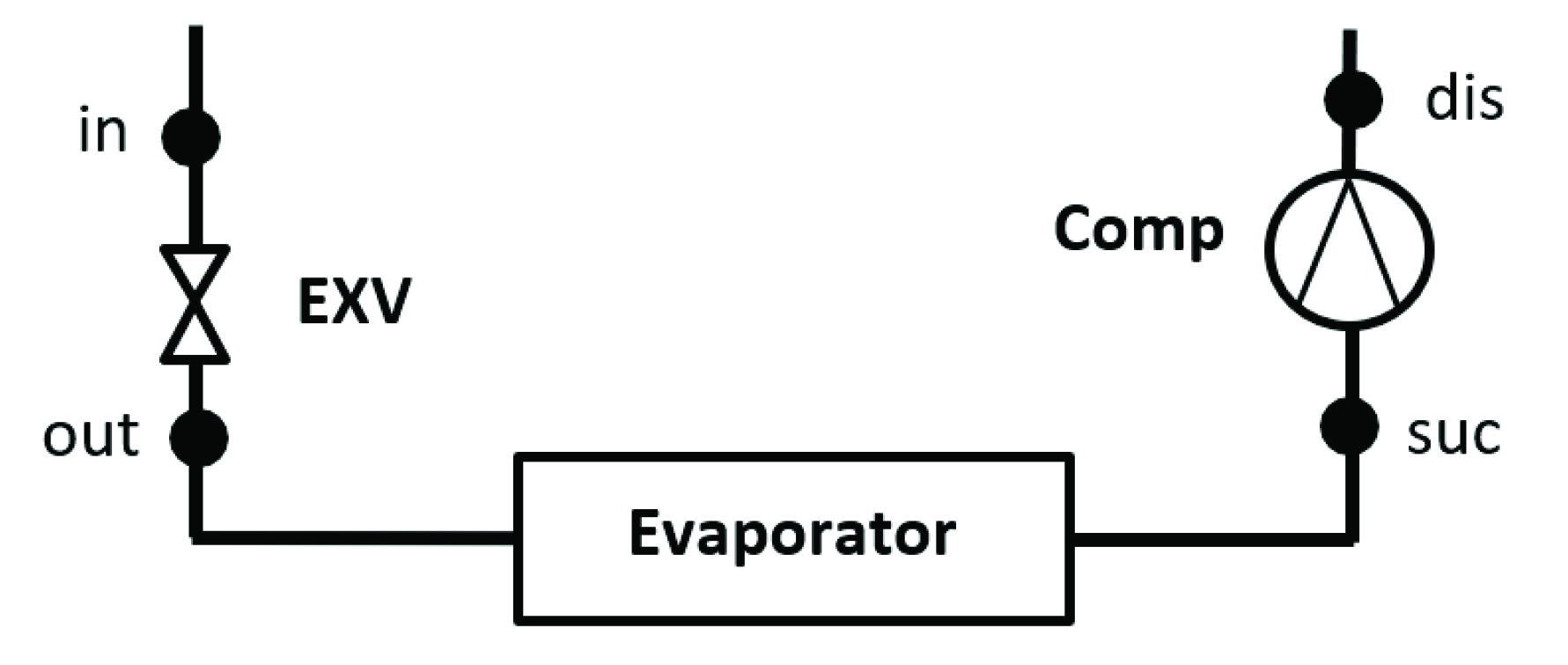
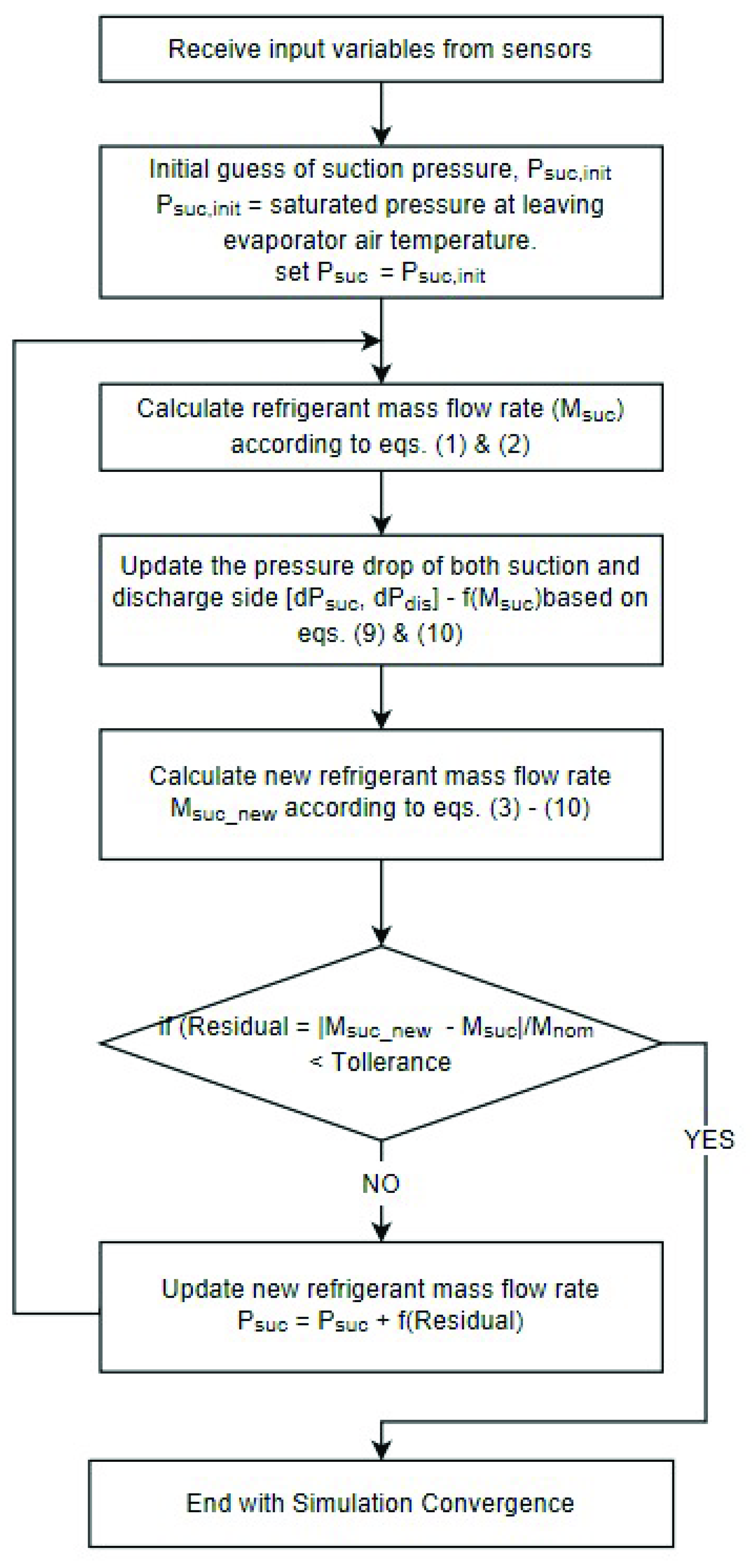
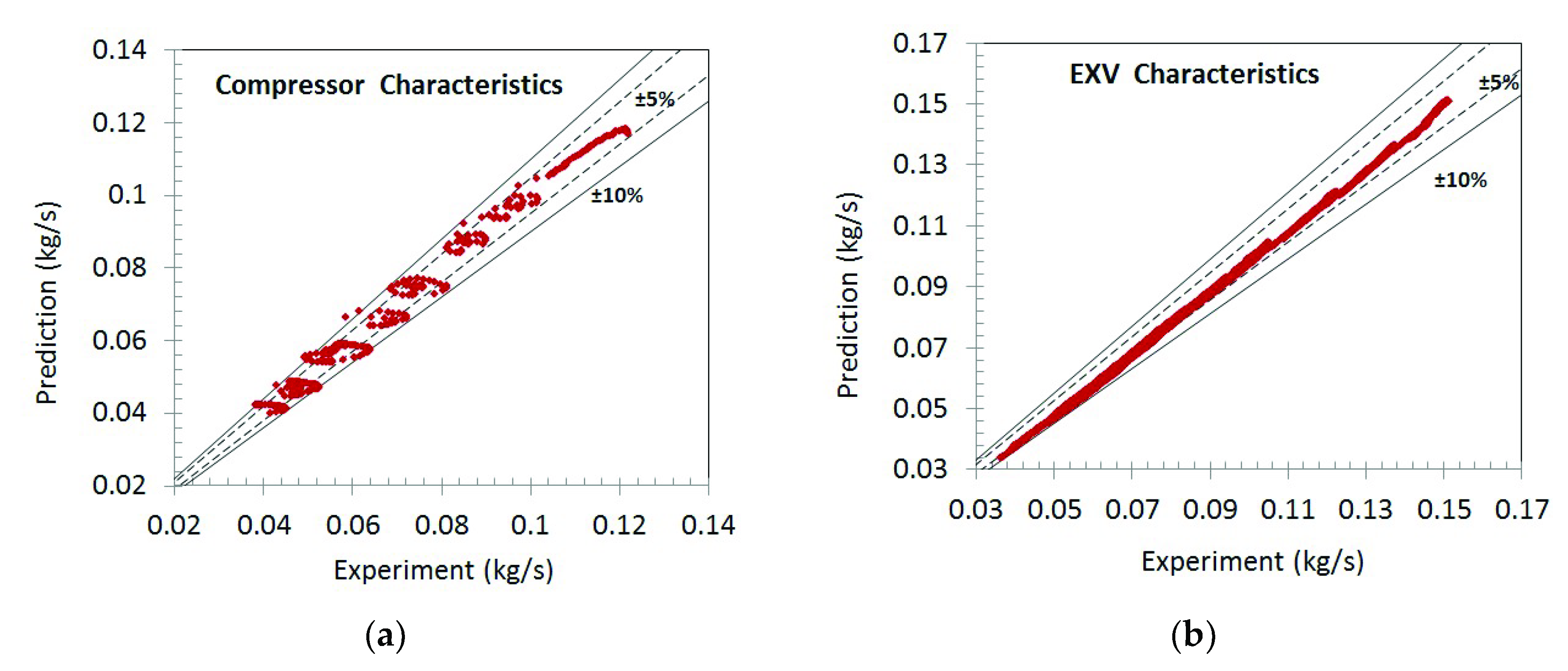

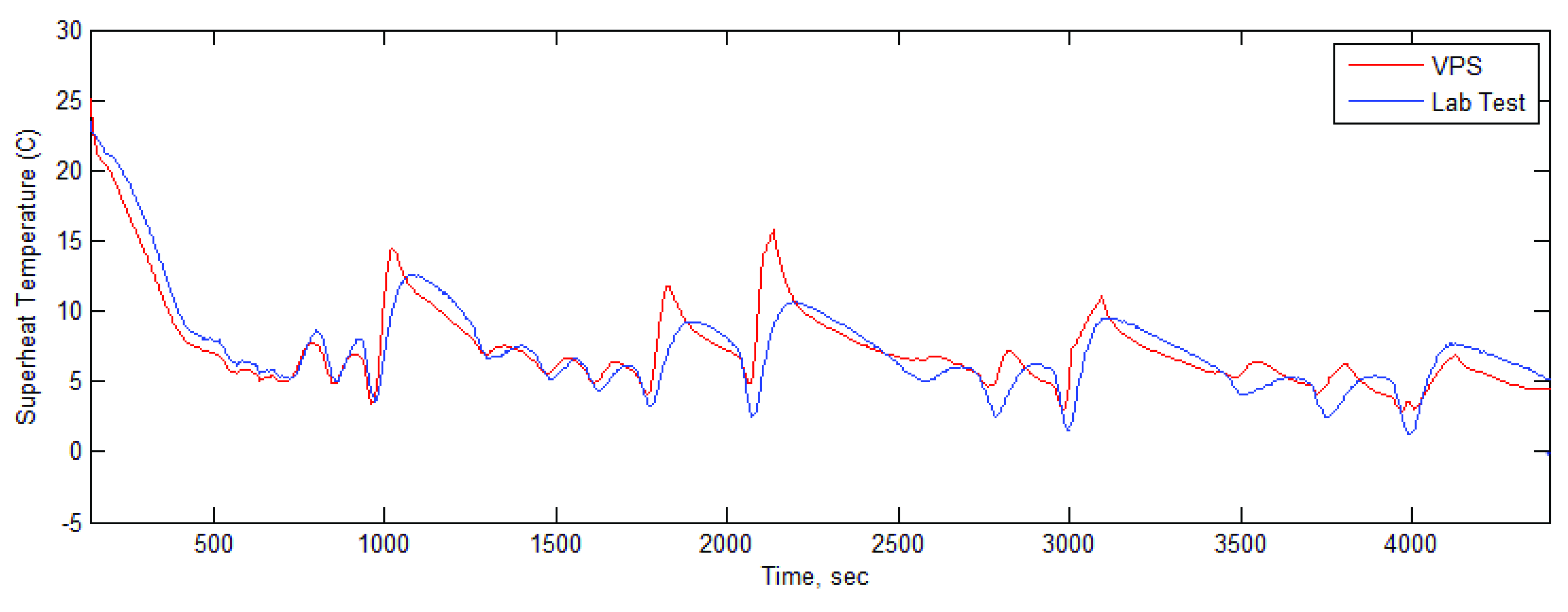


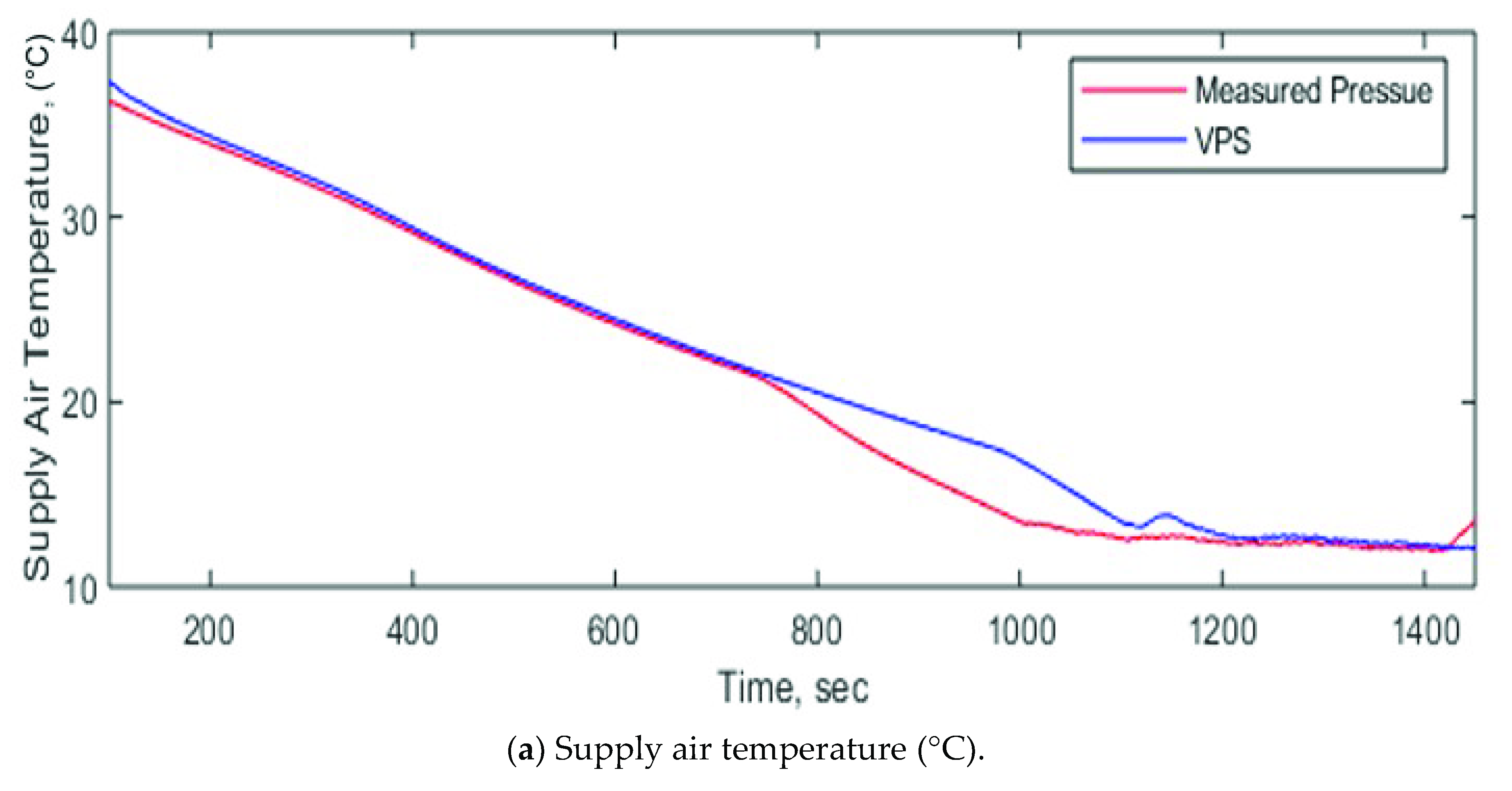



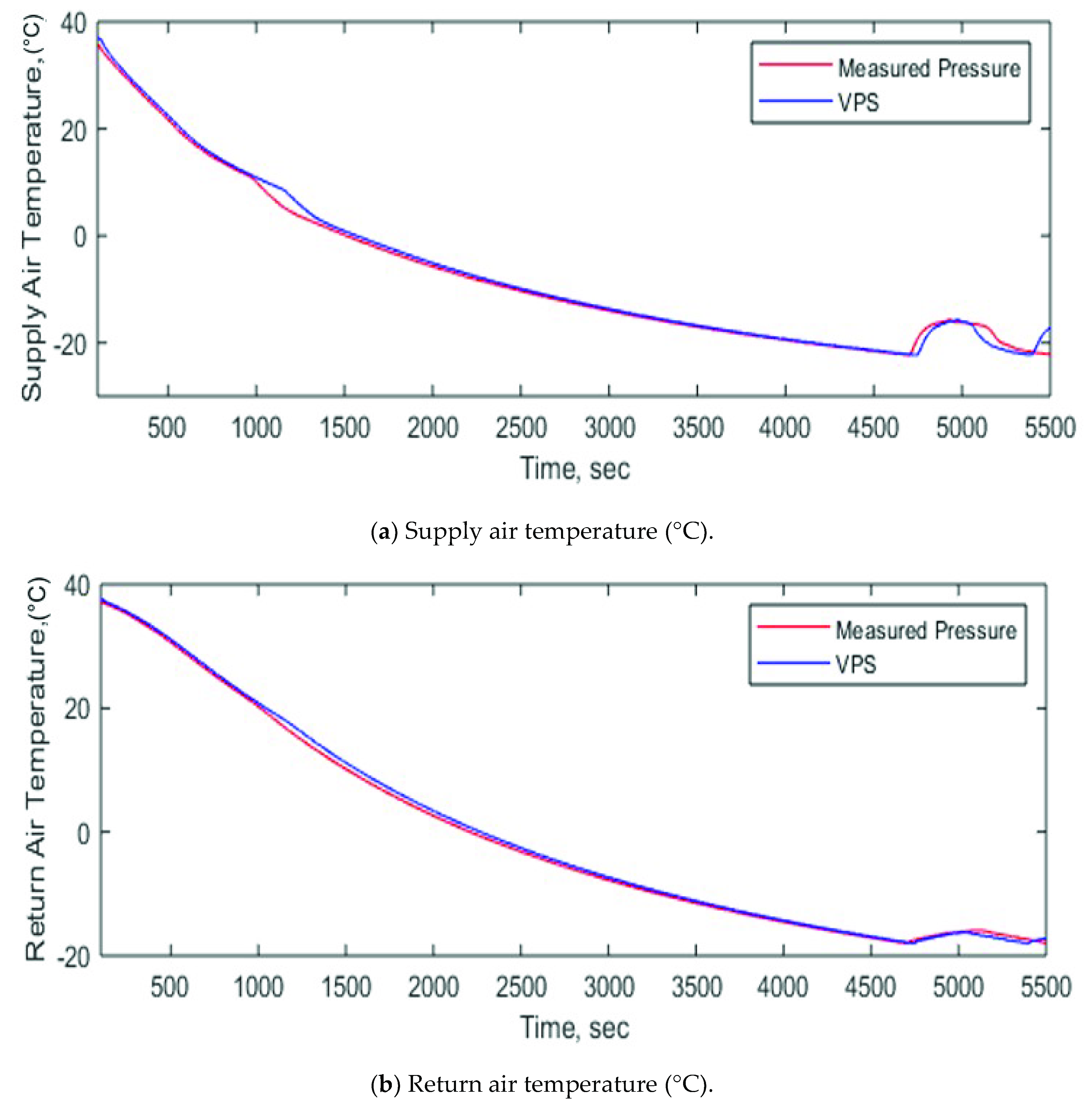

| Model Parameters | |
|---|---|
| γ | 1.13 |
| Ncomp | 3600 rpm |
| Vdisp | 1.45 × 10−4 m3 |
| C0 | 0.0139 |
| C1 | −2.45783 × 10−5 |
| C2 | 2.7928 × 10−6 |
| C3 | −1.88744 × 10−8 |
© 2020 by the authors. Licensee MDPI, Basel, Switzerland. This article is an open access article distributed under the terms and conditions of the Creative Commons Attribution (CC BY) license (http://creativecommons.org/licenses/by/4.0/).
Share and Cite
Sun, J.; Dong, J.; Shen, B.; Li, W. Virtual Pressure Sensor for Electronic Expansion Valve Control in a Vapor Compression Refrigeration System. Energies 2020, 13, 4917. https://doi.org/10.3390/en13184917
Sun J, Dong J, Shen B, Li W. Virtual Pressure Sensor for Electronic Expansion Valve Control in a Vapor Compression Refrigeration System. Energies. 2020; 13(18):4917. https://doi.org/10.3390/en13184917
Chicago/Turabian StyleSun, Jian, Jin Dong, Bo Shen, and Wenhua Li. 2020. "Virtual Pressure Sensor for Electronic Expansion Valve Control in a Vapor Compression Refrigeration System" Energies 13, no. 18: 4917. https://doi.org/10.3390/en13184917
APA StyleSun, J., Dong, J., Shen, B., & Li, W. (2020). Virtual Pressure Sensor for Electronic Expansion Valve Control in a Vapor Compression Refrigeration System. Energies, 13(18), 4917. https://doi.org/10.3390/en13184917




